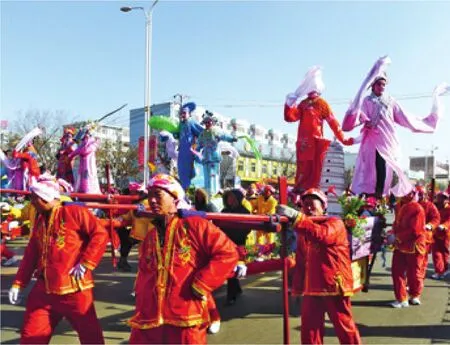Shehuo Festival
2012-10-14ByAyakoKatsumata
By Ayako Katsumata
Shehuo Festival
By Ayako Katsumata

UNIQUE PARADE:Local peop le ho ld a parade to celebrate Shehuo Festival in Zuoquan County o f Shanxi Province on February 6, which is the 15th day o f the first m onth in the Chinese lunar calendar
A fter living in Beijing for 10 years, I have gotten used to seeing people send off the Chinese Spring Festival w ith the Lantern Festival on the 15th day of the first month in the Chinese lunar calendar.At the Lantern Festival, people usually eat rice dumplings, watch fireworks and appreciate lanterns. In this way, they end the Spring Festival holiday and start a new year.
Recently, I discovered there was another sim ilar festival on the same day in Jinzhong City, north China’s Shanxi Province: theShehuoFestival. At this festival, in addition to fi reworks and lanterns, local people celebrate w ith various folk performances.
Located in the center of Shanxi Province,Jinzhong is 500 km or about five hours’ drive from Beijing. It has long been famous for the ancient city of Pingyao, which was the best preserved ancient city in China and was listed as a World Heritage Site in 1997. In 2007, the city won another big honor. It was the title“Cradle ofShehuo.”
TheShehuoFestival dates back 2,500 years.Sherefers to the god of land andhuorefers to the god of fi re. So this festival was originally held to worship the two gods. The festival hit a peak during the M ing Dynasty(1368-1644) and the Qing Dynasty (1644-1911). The major reason was the rise of the Shanxi merchants during the two dynasties.The economic prosperity boosted the development of culture and entertainment.
Today, the festival has become an annual celebration supported by the government.Everyone can participate if they want to. The most eye-catching part of the festival is, of course, the parade. In the parade, there are all kinds of folk performances. You can watch gong and drum beating, dragon and lion dances, stilt-walking and land boat dances.
Of all the counties in Jinzhong, Zuoquan preserves the most traditional elements.
In Zuoquan, all people, young and old,love singing and dancing. Singing and dancing is an indispensable part of their life.That’s why the county is known as a county of Chinese folk art. Every village has performing groups called art troupes or art teams.Children must learn folk songs and dances in kindergarten and elementary schools. During theShehuoFestival, temporary stages are set up in the streets. You can hear and watch the singing and dancing crowd everywhere.
Zuoquan’sShehuoFestival is divided into three types:Wen,WuandChou.Wenrefers to a local opera combining music, dance and drama.Wurefers to Chinese martial arts. AndChouis a clown show.
There is an interesting custom during the festival. People set up a cone-shaped pile of firewood or coal outside the door of every household. The art troupe performs beside the fi re, and the host family w ill treat them to walnuts, peanuts and cigarettes.
In addition to worshipping the gods of land and fi re, local people regard the festival as an opportunity to force out evils and illnesses, and pray for happiness.
The expense of holding the activities is usually paid by the art troupes, which are supported by the village administrations. The specific figure is decided by the financial condition of individual villages. I was astonished to hear that this figure can be as much as 300,000 yuan ($47,640). This reveals the popularity of theShehuoFestival among local people.
Maybe because of the long journey and the fact that the villagers have little contact w ith the outside world, the local folk arts are well preserved. This made me a little worried.In the modern world w ith advanced transportation and information networks, can the festival be handed down complete and intact?
Due to the advancement of urbanization,many folk activities and arts have disappeared in cities. Luckily, they are well kept in villages. But now that the villages w ill also start industrial development, will these folk activities and arts have the same ending as they did in cities?
A feasible solution is to make it the government’s responsibility to hold largescale activities such as theShehuoFestival celebration. In the meantime, a strong sense of the importance of protecting traditions is also required for the public. Seeing the happy faces of the performers and audiences around the bonfire during the festival in Zuoquan, I was deeply touched. Anyone who gets near the bonfi re can definitely feel that the smiling faces are the strongest force in protecting the local traditions.
